Firoloida
Firoloida desmaresti
Roger R. SeapyIntroduction
Firoloida desmaresti is a monotypic species with a cosmopolitan distribution. It is the smallest (maximal body length of 40 mm) and most transparent species in the family Pterotracheidae. The visceral nucleus is terminal on the trunk, followed by a short ventral tail and either a permanent egg string (in females) or a tail filament (in males). Prominent tentacles and a fin sucker are present in males, but are absent in females.
Brief Diagnosis
A pterotracheid with:
- elongated, cylindrical body divided into a proboscis, trunk and a very short tail
- tentacles, fin sucker and tail filament only in males
- permanent egg string in females
Characteristics
- Body morphology
- Body elongate, cylindrical
- Proboscis short relative to the long trunk
- Visceral nucleus terminal on trunk
- Tail ventral and short
- Sexually dimorphic characters
- Permanent egg string extends posteriorly from base of visceral nucleus in females
- Tail filament posterior to visceral nucleus in males
- Ventral sucker small and located on anterior margin of swimming fin in males
- Tentacles prominent, located anterior to eyes in males
- Eye morphology
- Lens capsule oblong, with lens basal and distal portion slightly opaque
- Radula
- Central tooth bears two long, sickle-shaped and pointed posterior processes on its basal plate

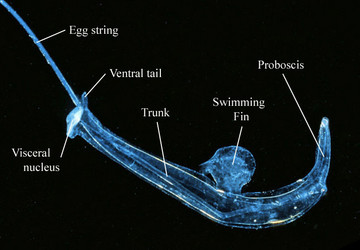
Figure. Location of body regions and structures in Firoloida desmaresti. ©

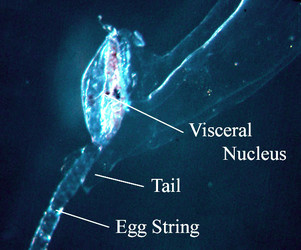
Figure. Posterior body region, right side in female Firoloida desmaresti. ©

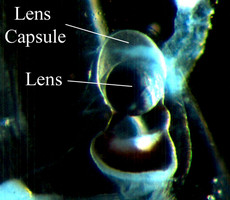
Figure. Dorsal view of right eye in male Firoloida desmaresti.©
References
Lalli, C. M. and R. W. Gilmer. 1989. Pelagic snails. The biology of holoplanktonic gastropod mollusks. Stanford Univ. Press, Stanford, pp. 1-259.
Richter, G. and R. R. Seapy. 1999. Heteropoda, pp. 621-647. In: D. Boltovskoy (ed.), South Atlantic Zooplankton. Leiden: Backhuys Publ.
Tesch, J. J. 1949. Heteropoda. Dana Rep. 34, pp. 1-53.
About This Page
Roger R. Seapy

California State University, Fullerton, California, USA
Correspondence regarding this page should be directed to Roger R. Seapy at
Page copyright © 2007
- First online 05 June 2007
- Content changed 05 June 2007
Citing this page:
Seapy, Roger R. . 2007. Firoloida . Firoloida desmaresti . Version 05 June 2007 (under construction). http://tolweb.org/Firoloida_desmaresti/28736/2007.06.05 in The Tree of Life Web Project, http://tolweb.org/




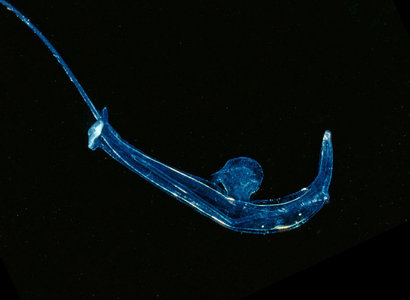
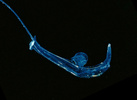


 Go to quick links
Go to quick search
Go to navigation for this section of the ToL site
Go to detailed links for the ToL site
Go to quick links
Go to quick search
Go to navigation for this section of the ToL site
Go to detailed links for the ToL site